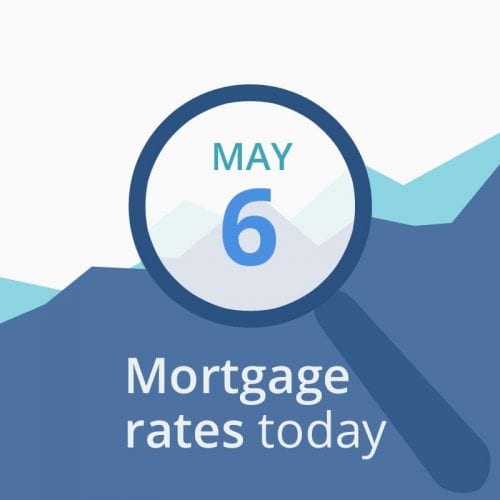
What’s driving current mortgage rates?
Average mortgage rates held steady for a second consecutive day on Friday. We’d expected a modest fall but had warned of “the possibility of markets waking up during the day.” After a busy Friday-to-Friday week that had had the potential to see the emergence of a new trend, those rates ended up with a barely perceptible change: just slightly higher.
U.S.-China trade talks took center stage around the world overnight, following aggressive tweets on Sunday by President Trump. In the short term, reaction to those could be good for mortgage rates. However, if negotiators prove able to still move forward, any gains could be short lived. Discover what’s going on by reading our “China” section, below.
The data below the rate table are indicative of mortgage rates falling today.
» MORE: Check Today’s Rates from Top Lenders (May 6, 2019)
| Program | Rate | APR* | Change |
|---|---|---|---|
| Conventional 30 yr Fixed | 4.188 | 4.188 | Unchanged |
| Conventional 15 yr Fixed | 3.808 | 3.808 | Unchanged |
| Conventional 5 yr ARM | 4.188 | 4.682 | Unchanged |
| 30 year fixed FHA | 3.75 | 4.738 | Unchanged |
| 15 year fixed FHA | 3.688 | 4.638 | Unchanged |
| 5 year ARM FHA | 3.75 | 5.128 | Unchanged |
| 30 year fixed VA | 3.87 | 4.045 | Unchanged |
| 15 year fixed VA | 3.75 | 4.063 | Unchanged |
| 5 year ARM VA | 3.938 | 4.404 | Unchanged |
| Your rate might be different. Click here for a personalized rate quote. See our rate assumptions here. | |||
Financial data affecting today’s mortgage rates
First thing this morning, markets looked set to deliver lower mortgage rates today. By approaching 10:00 a.m. (ET), the data, compared with this time on Friday, were:
- Major stock indexes were all appreciably lower soon after opening (good for mortgage rates). When investors are buying shares they’re often selling bonds, which pushes prices of Treasuries down and increases yields. The opposite happens on days like today. See below for a detailed explanation
- Gold prices edged down to $ 1,279 from $ 1,280. (Neutral for mortgage rates because the movement was so small.) In general, it’s better for rates when gold rises, and worse when gold falls. Gold tends to rise when investors worry about the economy. And worried investors tend to push rates lower)
- Oil prices held steady at $ 62 a barrel (neutral for mortgage rates, because energy prices play a large role in creating inflation)
- The yield on 10-year Treasuries fell to 2.49 percent from 2.52 percent. (Good for borrowers). More than any other market, mortgage rates tend to follow these particular Treasury yields
- CNNMoney’s Fear & Greed Index tumbled to 49 from 65 out of a possible 100. (Good for borrowers. “Greedy” investors push bond prices down (and interest rates up) as they leave the bond market and move into stocks, while “fearful” investors do the opposite. So lower readings are better than higher ones
Today might be a good day for mortgage rates.
Verify your new rate (May 6, 2019)
China talks
Markets around the world were largely focused on current, months-long U.S.-China trade talks overnight and this morning. That’s because yesterday President Trump tweeted two messages that could either accelerate the talks’ swift and successful conclusion — or blow them up. The tweets threatened to maintain, hike or impose tariffs on all Chinese imports this Friday.
Presumably, the President would see this as “the art of the deal” in action. But markets so far seem less convinced that such a high-risk strategy will play out well. And it’s hard to see how the Chinese leadership could cave to such threats without losing face both at home and around the world. Chinese newspapers were speculating overnight that a scheduled visit to Washington DC this week by its chief negotiator Vice-Premier Liu He and his team might be postponed, canceled or foreshortened. However, a government spokesperson later confirmed the trip would go ahead.
All this has made global markets jittery. By chance, those in London and Tokyo are closed for public holidays, but others didn’t respond well. Stocks in Beijing tumbled almost 6 percent on the news. As you can see from the above financial data, the reaction wasn’t as sharp on Wall Street but was nevertheless significant.
How things stood on Friday
For background, here is how we characterized the situation before the President’s tweets:
Both sides have worked long (President Trump’s original deadline passed many weeks ago) and hard to iron out problems.
There are now signs the U.S. may be making concessions. Last week, the South China Morning Post cited reports that:
… Trump has softened his administration’s opening negotiating position from what it originally characterised as “Chinese government-conducted, sponsored, and tolerated cyber intrusions into US commercial networks”… Since trade talks resumed in December, Washington and Beijing say they have made gains on various issues, including intellectual property, forced technology transfer and non-tariff barriers. But an enforcement mechanism and punitive tariffs remain sticking points.
On Friday, President Trump told reporters at the White House:
“The deal itself is going along pretty well. I would even say very well. We’ll see what happens over the next couple of weeks. But we’re getting close to a very historic, monumental deal. And if it doesn’t happen, we’ll be fine too. Maybe even better.”
Certainly, both sides badly need a good outcome, and for similar reasons: First, to burnish political prestige domestically by bringing home a win. And secondly, to step back from economic slowdowns.
However, some worry those pressures will prevent a win-win conclusion — and might even result in no deal being reached (was the President on Friday hinting that remains a possibility?) or a lose-lose one. Once the talks end, investors will digest the outcome in detail. If no deal is concluded, or if the one that’s agreed turns out to be worse than neutral for the U.S., expect mortgage rates to tumble. But, if it’s a win-win — or even just not too terrible and simply brings uncertainty to an end — they could rise.
Rate lock recommendation
Consider buying discount points
Mortgage News Daily (MND) made a good case recently for purchasing discount points. For some borrowers, these are currently unusually cheap and represent good value. However, not all lenders are offering these bargains and their availability may change with market conditions. So you should explore your options with your loan officer or another professional.
Here’s MND’s thinking: “… for most lenders, it makes almost no sense to lock a rate of 4.25% or 4.75% today (assuming a conventional 30yr fixed…) because the cost to buy down to 4.125% and 4.625% respectively is so much smaller than normal.”
Trends
Trends are impossible to discern from just a few days’ changes. So don’t read too much into recent fluctuations. Frustrating though it is, there really is no way of knowing immediately what movements over a brief period mean in their wider context.
Even when one’s discernable, trends in markets never last forever. And, even within a long-term one, there will be ups and downs. Eventually, at some point, enough investors decide to cut losses or take profits to form a critical mass. And then they’ll buy or sell in ways that end that trend. That’s going to happen with mortgage rates. Nobody knows when or how sharply a trend will reverse. But it will. That might not be wildly helpful but you need to bear it in mind. Floating always comes with some risk.
Of course, it’s possible the Federal Reserve’s March statement on rates has established a long-term downward trend. But you can still expect to see rises and falls (such as those over the last several weeks) within it as other risk factors emerge and recede. And, depending on how near you are to your closing date, you may not have time to ride out any increases.
Risks from a future recession
Of course, a recession couldn’t, by definition, arise before you close. But the more investors suspect there’s one on the horizon, the lower mortgage rates are likely to go.
Last Friday’s better-than-expected employment data followed the previous Friday’s better-than-expected GDP figures. And, between the two, there had been other generally positive reports, including one about productivity. You might normally have expected those to generate higher mortgage rates. At other times, they might even have created a clear upward trend. But not now.
Some of this may be down to investors reading beyond the headline figures in economic reports. For example, NASDAQ’s Weekly Economic Release Summary, published Friday, said, “… the GDP internals were weak even though the reported overall number was strong.” But some of it may be down to underlying skepticism over the sustainability of growth based on a one-time, massive tax cut.
So, for now, markets seem unable to make up their minds what the future holds. If and when they do, mortgage rates could rise (on optimism) or fall (on pessimism).
We suggest
Last Wednesday’s Fed announcement didn’t move policy on from that declared after March’s meeting. That was doveish and ruled out further rate hikes this year And it will likely continue to add some downward pressure on mortgage rates in coming months. As we’ve seen in recent weeks, that doesn’t mean there aren’t other risks (currently known and unknown) that could see them rise, possibly sharply. We suggest that you lock if you’re less than 30 days from closing.
Of course, financially conservative borrowers might want to lock immediately, almost regardless of when they’re due to close. On the other hand, risk takers might prefer to bide their time. Only you can decide on the level of risk with which you’re personally comfortable.
If you are still floating, do remain vigilant right up until you lock. Continue to watch key markets and news cycles closely. In particular, look out for stories that might affect the performance of the American economy. As a very general rule, good news tends to push mortgage rates up, while bad drags them down.
When to lock anyway
You may wish to lock your loan anyway if you are buying a home and have a higher debt-to-income ratio than most. Indeed, you should be more inclined to lock because any rises in rates could kill your mortgage approval. If you’re refinancing, that’s less critical and you may be able to gamble and float.
If your closing is weeks or months away, the decision to lock or float becomes complicated. Obviously, if you know rates are rising, you want to lock in as soon as possible. However, the longer your lock, the higher your upfront costs. On the flip side, if a higher rate would wipe out your mortgage approval, you’ll probably want to lock in even if it costs more.
If you’re still floating, stay in close contact with your lender, and keep an eye on markets. I recommend:
- LOCK if closing in 7 days
- LOCK if closing in 15 days
- LOCK if closing in 30 days
- FLOAT if closing in 45 days
- FLOAT if closing in 60 days
» MORE: Show Me Today’s Rates (May 6, 2019)
This week
After last week’s feast of economic data, this week sees a famine. It’s possible Friday’s consumer price index (CPI) report could move markets. However, the others on the calendar are unlikely to do so.
Of course, it remains true that any economic report can cause waves if it contains sufficiently shocking data. But probably not this week.
Forecasts matter
Markets tend to price in analysts’ consensus forecasts (below, we use those reported by MarketWatch) in advance of the publication of reports. So it’s usually the difference between the actual reported numbers and the forecast that has the greatest effect. That means even an extreme difference between actuals for the previous reporting period and this one can have little immediate impact, providing that difference is expected and has been factored in ahead. Although there are exceptions, you can usually expect downward pressure on mortgage rates from worse-than-expected figures and upward on better ones. However, for most reports, much of the time, that pressure may be imperceptible or barely perceptible.
- Monday: Nothing
- Tuesday: March job openings (forecast TBA million jobs). Also, consumer credit data for March will be published at 3:00 p.m. (ET)
- Wednesday: Nothing
- Thursday: March trade deficit (forecast -$ 50.0 billion) and April producer price index (forecast +0.2 percent)
- Friday: April consumer price index (CPI — forecast +0.4 percent), including core CPI (forecast +0.2 percent). Also, the federal budget will be published at 2:00 p.m. (ET)
That’s a heavy schedule for one week.
What causes rates to rise and fall?
Mortgage interest rates depend a great deal on the expectations of investors. Good economic news tends to be bad for interest rates because an active economy raises concerns about inflation. Inflation causes fixed-income investments like bonds to lose value, and that causes their yields (another way of saying interest rates) to increase.
For example, suppose that two years ago, you bought a $ 1,000 bond paying 5 percent interest ($ 50) each year. (This is called its “coupon rate” or “par rate” because you paid $ 1,000 for a $ 1,000 bond, and because its interest rate equals the rate stated on the bond — in this case, 5 percent).
- Your interest rate: $ 50 annual interest / $ 1,000 = 5.0%
When rates fall
That’s a pretty good rate today, so lots of investors want to buy it from you. You can sell your $ 1,000 bond for $ 1,200. The buyer gets the same $ 50 a year in interest that you were getting. It’s still 5 percent of the $ 1,000 coupon. However, because he paid more for the bond, his return is lower.
- Your buyer’s interest rate: $ 50 annual interest / $ 1,200 = 4.2%
The buyer gets an interest rate, or yield, of only 4.2 percent. And that’s why, when demand for bonds increases and bond prices go up, interest rates go down.
When rates rise
However, when the economy heats up, the potential for inflation makes bonds less appealing. With fewer people wanting to buy bonds, their prices decrease, and then interest rates go up.
Imagine that you have your $ 1,000 bond, but you can’t sell it for $ 1,000 because unemployment has dropped and stock prices are soaring. You end up getting $ 700. The buyer gets the same $ 50 a year in interest, but the yield looks like this:
- $ 50 annual interest / $ 700 = 7.1%
The buyer’s interest rate is now slightly more than seven percent. Interest rates and yields are not mysterious. You calculate them with simple math.
Show Me Today’s Rates (May 6, 2019)
Mortgage rate methodology
The Mortgage Reports receives rates based on selected criteria from multiple lending partners each day. We arrive at an average rate and APR for each loan type to display in our chart. Because we average an array of rates, it gives you a better idea of what you might find in the marketplace. Furthermore, we average rates for the same loan types. For example, FHA fixed with FHA fixed. The end result is a good snapshot of daily rates and how they change over time.
Mortgage Rates, Mortgage News and Strategy : The Mortgage Reports





